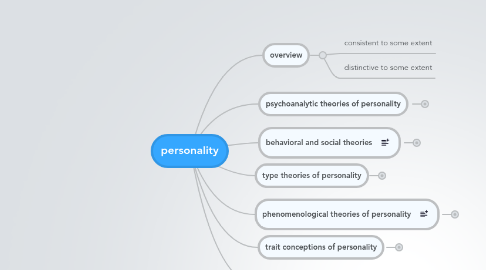
1. psychoanalytic theories of personality
1.1. origins
1.1.1. Freud
1.1.2. traumatic experiences
1.1.3. unconscious
1.2. the structure of the mind
1.2.1. id, unconscious, pleasure principle
1.2.2. ego, conscious, reality principle
1.2.3. superego, partly conscious, ethical principle
1.3. defense mechanisms
1.3.1. psychotic
1.3.2. immature
1.3.3. neurotic
1.3.4. mature
1.4. drawbacks
1.4.1. the examiner needs specialized training
1.4.2. the process is very time-consuming
2. type theories of personality
2.1. humoral theory with four personality types
2.2. type A coronary-prone behavior pattern
3. phenomenological theories of personality
3.1. Kierkegaard, Existentialism, concerned with the meaning of life
3.2. Carl Rogers, self-theory, q-sort
3.2.1. self-sort v.s. ideal-sort
4. behavioral and social theories
4.1. Internal-External (I-E) scale by Rotter
4.2. self-efficacy by Bandura
5. trait conceptions of personality
5.1. Factor-Analytic Trait Theory by Cattell
5.1.1. surface traits
5.1.2. source traits
5.1.3. 16 personality factor questionnaire
5.2. Trait-Dimensional Theory by Eysenck
5.2.1. introverted-extraverted, emotionally stable
5.2.2. Hippocrates 4 temperaments
5.3. comment on the trait concept
5.3.1. whether traits cause behavior or merely describe behavior?
5.3.2. low predictive validity r = .30
5.4. The Five-Factor Model of Personality
6. the projective hypothesis
6.1. association techniques
6.1.1. Rorschach, 5 black and 5 colored.
6.1.1.1. two phases
6.1.1.2. RPRScale
6.1.1.3. TDI
6.1.1.4. comment
6.2. completion techniques
6.2.1. sentence completion
6.2.2. Rotter Incomplete Sentences Blank (RISB)
6.2.2.1. the objective scoring system
6.2.2.2. high reliability
6.3. construction techniques
6.3.1. The Thematic Apperception Test (TAT)
6.3.2. The Picture Projective Test (PPT)
6.3.3. Children's Apperception Test (CAT)
6.3.4. other variations on the TAT
6.4. expression techniques
6.4.1. The Draw-A-Person Test (DAP)
6.4.2. The House-Tree-Person Test (H-T-P)

